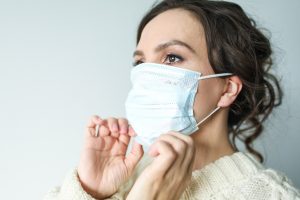Are homemade masks effective against coronavirus? We are doing everything that we can to stay protected. From social distancing to going out only when we must. Hospitals across the country have reached surge capacity due to the coronavirus outbreak and personal protective equipment is currently limited. Even more, doctors are re-wearing masks that should be single-use only. In extreme cases, doctors and nurses are not wearing masks at all due to hospitals not having any masks available. With this immediate need from doctors and nurses, many Americans are considering making their own face masks. However, the question is how effective this can be, and should we wear homemade masks at all?
The Center for Disease Control and Prevention recently released a list of strategies to help us optimize face mask supplies. According to their statement, homemade masks such as scarves and bandanas should be used only as a last resort. There are many pros and cons to wearing a mask. Many are concerned that buying and hoarding masks could leave healthcare specialists with none while those who don’t need them at all have plenty.

Should you make your own mask?
The Center for Disease Control and Prevention (CDC) wrote:
“Homemade masks are not considered PPE since their capability to protect health care personnel (HCP) is unknown. Caution should be exercised when considering this option.”
This means that homemade masks and scarves are better options than nothing especially if you have the virus or you are treating someone who has the virus.
Amy Shah, an integrative medicine doctor explained:
“Homemade masks or scarves are good at catching your respiratory droplets if you are sick. It’s not necessarily great protection if you’re not sick, though.”
Additionally, CDC recommended that with a homemade mask, people should be wearing a face shield which would ideally cover your whole face including both sides of your face and beyond your chin.
Should we wear masks and if we should, who should wear masks?
Specialists haven’t been clear on this, and WHO said that masks can do more harm than protect us if the masks are not used correctly. According to the CDC:
“Face masks may be in short supply and they should be saved for caregivers.”
Those who are infected should wear masks but since research suggests that some people might be infected but asymptomatic or have only mild symptoms, it can be difficult to know who should wear a mask and who shouldn’t, meaning who is sick and who is healthy. This is the main reason why health professionals recommend wearing a mask. The White House is not 100% clear on this message and Deborah Birx, M.D. and coronavirus correspondent said:
“The task force is still discussing whether to change the recommendation on masks.”
Regardless, Shah is completely right when she said that health workers should have masks available to them and not struggle to get these on time.
If you are using a homemade, cloth mask it’s important to wash it regularly with hot water and soap and make sure you are washing your hands once you wash the mask. Additionally, avoid readjusting a mask, and touching other parts of your body in order to prevent cross-contamination of a virus. As Shah said:
“We release droplets while talking, singing, and shouting—it doesn’t have to be sneezing and coughing.”
Additionally, wearing a mask stops us from touching our face while we are outside.
In conclusion, staying inside and practicing social distancing is the most effective way of staying safe and flattening the curve. So whether you have a mask or not, make sure you are practicing social distancing. Stay safe.




